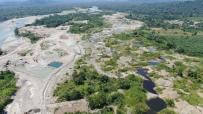
The ashéninka community of Sawawo is located at the easternmost point of the Ucayali Amazon region. It is the last Peruvian town on the border with Brazil, on the banks of the Amônia River. Getting here from the Brazilian side is less complex than from Peru, where the nearest town is several days’ walk and boat ride away.
An OjoPúblico team left the town of Marechal Thaumaturgo, in the Brazilian state of Acre, and after three hours by boat, arrived in the Ashaninka community of Apiwtxa. From there to Sawawo, on the Peruvian side, the distance is only three hours by boat. On the map, an imaginary straight line separates the two countries. In practice, the border landmark is just a small plate of wood nailed into a tree where someone has written in ink: “Peru-Brazil Milestone 40".
Sawawo is a community of 127 people, according to their own count. The Malocas have the same style but are simpler than the Apiwtxa. There used to be an airport, but it was disabled by a landslide. The Internet was installed just a year ago. Indigenous leaders tell us that OjoPúblico has been the first Peruvian media to reach the place. There is no government representation in tens of kilometers on either side of the border.
Drug trafficking and other activities, such as illegal logging, have made this border region a priority in the public security policy of the Brazilian state of Acre. “We created a specific intelligence core to address this issue in Cruzeiro do Sul [it is the second largest city in the state of Acre, after the capital Rio Branco], exclusively devoted to traffic in the region,” Acre’s justice and Public Security secretary, Paulo Cezar Rocha dos Santos, told OjoPúblico.

BORDER: On a piece of wood is written "Marco 40", the point that divides Peru from Brazil in a straight line.
Foto: OjoPúblico
According to Santos, Peru has also become a haven for at least four regional leaders of Comando Vermelho (CV), one of Brazil's leading criminal organizations, along with the CCP (First Capital Command), as well as other low-ranking members. The Brazilian authority notes that “in the area of repression, Yurua (in Ucayali) is our main concern in the face of this movement that is taking place in the region”.
The district of Yurua is located in the province of Atalaya. As is the case with other isolated areas of the Peruvian Amazonian borders, it has high poverty rates. The only means of transport are flights, if any, and by river. The capital of the district is Breu, although in Brazil it is called Tipishca.
International drug trafficking, illegal logging, and the settlement of suspicious forest concessions on the Peruvian side have turned the territory inhabited by the Peruvian and Brazilian indigenous communities into a scene of murky interests, internal conflicts, environmental crimes, and murders.
The presence of the Comando Vermelho (Red Command, en inglés) in the Peruvian Amazon has expanded in recent years due to the permissiveness of local authorities. It is one of Brazil's largest criminal organizations dedicated to drug trafficking, extortion, kidnapping and contract killings, and controls the corridors for the transit of cocaine and illegal timber.
“Some time ago, there were no white [people] on the Peruvian side, they were all Ashaninkas. We lived very close to the border, but then moved further into Brazil to guarantee our protection, to control, to manage. We couldn't imagine anyone invading our territory from Peru," says Francisco Piyãko, 53, the leader of Apiwtxa.

ASHÁNINKA PEOPLE. The Sawawo - Hito 40 indigenous community was recognized as such by the Peruvian government in 1998. It is located in the district of Yurua, in Ucayali.![]()
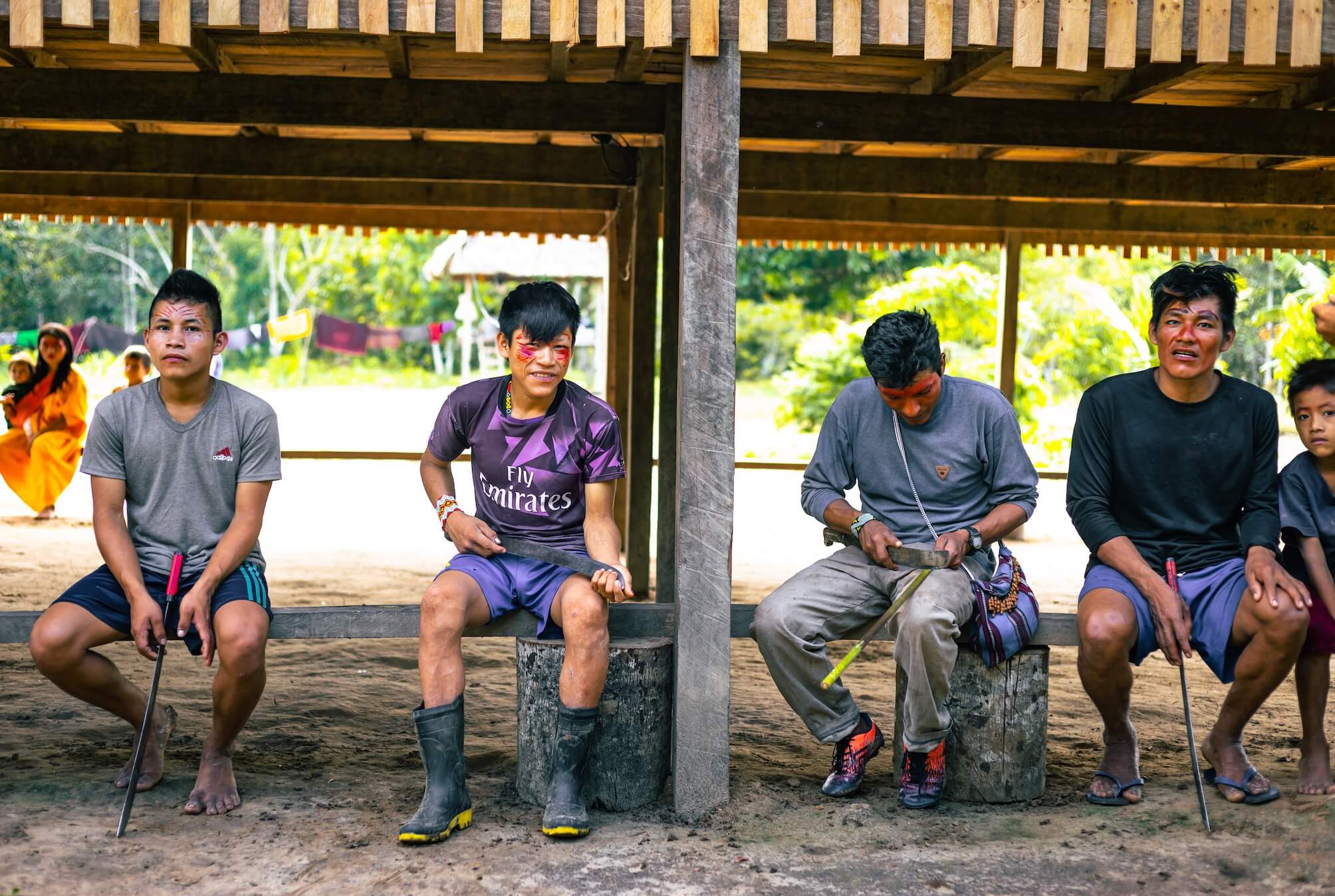
ACTIVITIES. Border families are involved in fishing, hunting, and agriculture. They maintain close communication with the Ashaninka communities in Brazil.
Fotos: OjoPúblico
The murder of Saweto leaders, Edwin Chota, Jorge Rios Pérez, Leoncio Quintisima Meléndez and Francisco Pinedo Ramirez, who had denounced and opposed illegal logging from their territories, revealed the levels of violence and impunity in the area. The four were killed as they headed from Saweto (Peru), located a day's walk through the forest, to the Brazilian community of Apiwtxa.
The crimes, attributed to illegal loggers by the Peruvian prosecutor's office, have not been tried to date. Eight years after the multiple murder, the trial is still in the criminal trial phase and not a single person has been arrested. Before he was murdered, Edwin Chota had handed over maps, coordinates, and names of the illegal loggers along the border.
In Acre, the Brazilian security secretary insists: "The Comando Vermelho has an alliance with Peruvian drug traffickers that guarantees the trafficking and protection of its criminals in the cities of the department of Ucayali.
Brazilian authorities identify as the main leader José Luiz Fonseca da Silva, known as Zé Luiz, identified by police as the head of drug trafficking on the Brazilian side of the Yurua basin (Juruá in Brazil). He is wanted by the Brazilian Justice for the crimes of organized crime, drug trafficking, attempted murder and illegal possession of firearm. In July 2019 he fled, when he was being taken to a court hearing.
Months later, in November 2019, he was captured while riding a motorcycle cab in the Lima neighborhood of Villa Maria del Triunfo. A false Peruvian identity and cocaine base paste were found with Zé Luiz. However, Peruvian authorities released him before he was extradited to Brazil.
When asked about the reasons for his release in Peru, the National Penitentiary Institute (Inpe) of Peru informed OjoPúblico that, after being arrested in Lima, the Brazilian citizen entered the Challapalca prison on December 2, 2019 for the crime of illegal possession of firearms. However, on July 2, 2021 he was released after the special criminal court of Villa El Salvador granted him restricted appearance.
Once released by the Peruvian justice system, Jose Luiz Fonseca da Silva continued to commit crimes along Peru's border with Brazil. And this year, on July 28, he died in a confrontation with Brazilian police in Cruzeiro do Sul.

HE WAS RELEASED. After being arrested in Lima in 2019, José Luiz Fonseca da Silva was released in 2021 by a judge in Villa El Salvador despite the fact that Brazilian authorities were requesting his extradition.
Foto: Peruvian National Police
The threat of drug trafficking and illegal logging
Apiwtxa appears behind one of the innumerable bends of the muddy Amônia River, tributary of the Brazilian Jurua River. It is located in a steep ravine, safe from flooding. The thatched and wood-roofed malocas stand on stilts and have large balconies. Apiwtxa Ashaninkas have planted açai and pupunha palm trees, ayahuasca vines, medicinal plants, and fruit trees. The wide space between malocas, the grassy islands surrounded by trees and the use of kushma by all the inhabitants are part of the atmosphere of this village in Brazil.
This Brazilian community is one of the most in contact with other Peruvian indigenous communities on the border. The indigenous leaders of the Asheninka Saweto community, Edwin Chota, Jorge Rios Pérez, Leoncio Quintisima Meléndez and Francisco Pinedo Ramirez, were heading to this place, where several coordination meetings were held, when they were abducted and killed in 2014 by illegal loggers on the Peruvian side. Saweto is just a day’s journey from Sawawo.
The Apiwtxa people have been there for three decades. When they managed to demarcate their territory in the early 90s, the first step was to relocate the community a few kilometers closer to the mouth of the Amônia River. The purpose of the move was to keep loggers, hunters, and other invaders away. They were not very much concerned about the headwaters of the Amônia River, which is on the Peruvian side, because it was considered a safe territory. But it is not anymore.
On the other hand, in the Ucayali region of Peru, criminal actions have increased in recent years. In April 2015, the authorities intercepted eight people from Brazil carrying 50 kilos of cocaine camouflaged in sacks in Puerto Putaya, located in the district of Coronel Portillo. In the intervention high-caliber weapons, such as shotguns, pistols, and a machine-gun, were also seized.
Such seizures linked to drug trafficking against Peruvians and Brazilians have continued since then. In March 2019, police intercepted 25 people in a clandestine drug laboratory and an illegal coca leaf plantation, also in Ucayali. In April of that same year, the then-Minister of Defense José Huerta said that the Armed Forces had a radar to track “narco-plane” flights in this area of Ucayali, but that it was out of service: It was “under maintenance.”

ASHÁNINKA COMMUNITY. The Apiwtxa community in Brazil is very close to the last Peruvian indigenous community in the area, Sawawo.

LEADER IN APIWTXA. The Asháninka leader in Brazil, Francisco Piyãko, is concerned about incursions by outsiders into their territories.
Fotos: OjoPúblico
The Apiwtxa Ashaninka leader, in Brazil, Francisco Piyãko, indicates that his concern about the situation on the Peruvian side has increased. He mentions interventions and incursions by persons outside the communities into their territories. “They continue on the Brazilian side and are now increasing on the Peruvian side. Even worse, we understand that this is coordinated between authorities and interests on the side of Brazil and Peru,” he ponders.
One of the facts most remembered by border leaders, as the beginning of insecurity in the area, dates back to 2007. Three Peruvians linked to then-Venao Forestal company were arrested by an official Brazilian patrol while illegally extracting timber from the Brazilian side. Since then, local leaders report that the presence of settlers engaged in illegal activities has increased in the vicinity of the communities.
In 2016, three employees who introduced themselves as representatives of a Ucayali logging company returned to this part of the border wanting to convince communities to engage in logging. Apiwtxa leaders intercepted them in Brazilian territory and prevented them from continuing their journey. But it was not the first time that they stopped loggers from Peru; something similar had already happened in 2011, on the same river, Amônia.
The Stalking of the Loggers
After a period of relative calm, tempers in Sawawo and Apiwtxa flared up again last year. In August 2021, the Sawawo Milestone 40 Community vigilance committee intervened, within its territory, a team of workers and two tractors from a company they identified as the logging company Inversiones Forestales JS, based in Ucayali.
A few days later, the community formally filed a criminal complaint against the company with the Atalaya environmental prosecutor, who ordered the machinery to be immobilized, but a court in Pucallpa reversed the order. Indigenous leaders emphasized that they have not given permission to any of the companies to extract timber from their territory.
The Association of Native Communities for the Comprehensive Development of Yurua Yono Shara Kumiai (Aconadiysh), which groups the Peruvian border communities, supports this complaint. The criminal complaint, which was released by NGO ProPurus – with projects in the area – emphasize that logging is affecting their communal territories and building a road that divides their farms.
The community vigilance committee precisely reported that outsiders were intercepted when they began to reopen an old road used years ago by Forestal Venao for timber extraction. This trail connects the banks of the Amônia River with Nueva Italia and Puerto Breu. Sawawo is a two-day boat ride or a day walk from Breu, the nearest town center.
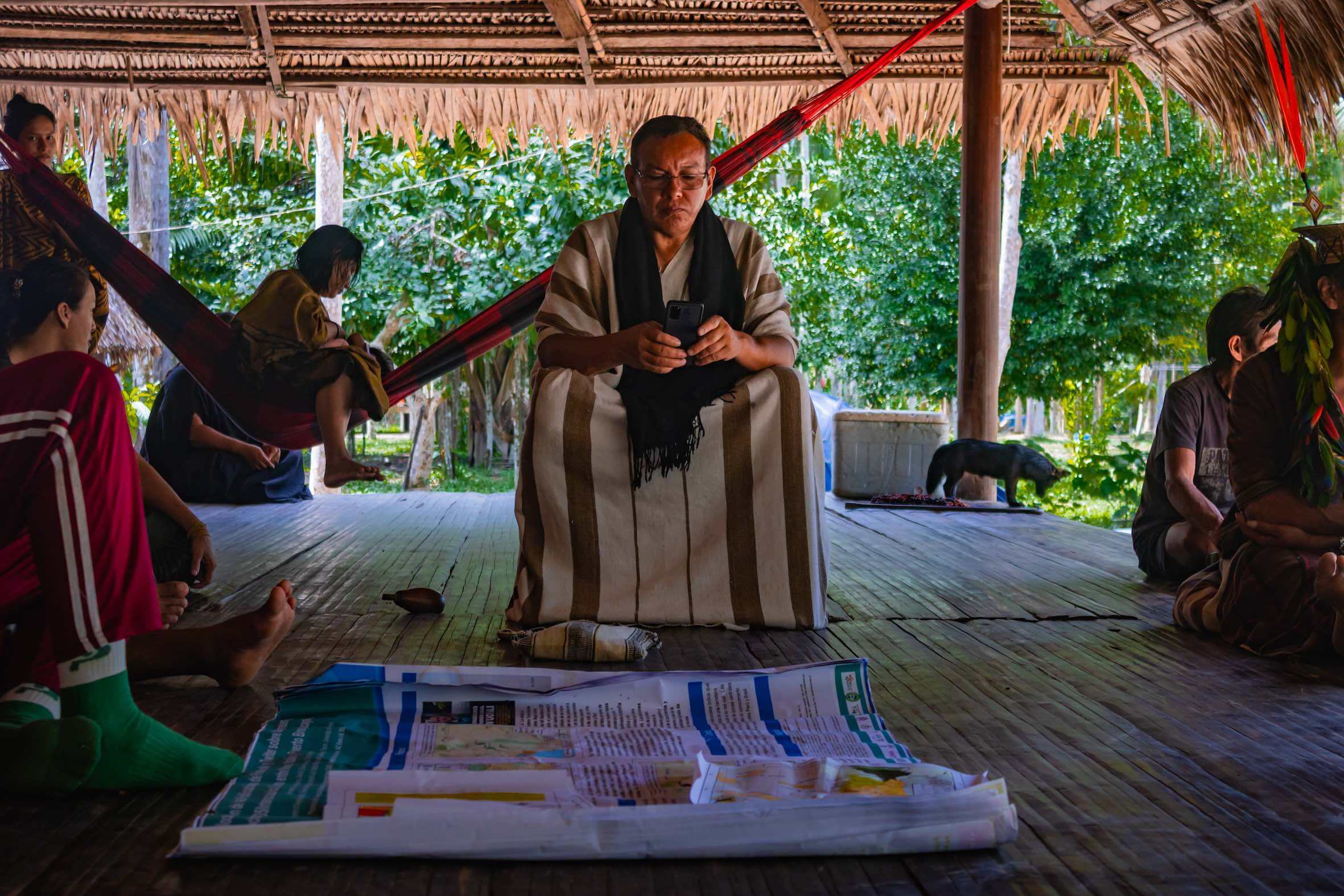
LEADERSHIP IN ACRE. The Asháninka leader of Apiwtxa, in Brazil, Francisco Piyãko
Foto: OjoPúblico
Sawawo Asheninkas told OjoPúblico that they have found ten streams blocked by timber extraction works. In addition, to reopen the road, trees from the reforestation carried out on the area, including mahogany, have been cut down.
“They had nothing in their hands, nothing was presented to us,” says Maria Elena Paredes, 42, coordinator of the Sawawo community forestry vigilance committee. “The property belongs to the community. When giving a permit, it is not. This company is used to making such agreements in secret. We have work goals with our forest."
A few years ago, Sawawo entered an agreement with Forestal Venao, but the experience was bad, and they no longer want the activity in their territory. They report unfulfilled promises and environmental impacts, such as deforestation and scarcity of game.
This time, JS logging company reached an agreement with the neighboring Asheninka community, Nueva Shahuaya, which generated a conflict between them, a rupture. "Before they signed this agreement, we got along well, we coordinated the work. After they signed on our back, there has been a conflict between the authorities. They wanted to defend the company," says Paredes.
The Sawawo patrol confiscated the keys of the tractors, which remained immobilized until November. According to Paredes, the machinery was removed with the help of Atalaya policemen who threatened a Sawawo leader.
The agreement between JS and Nueva Shahuaya is illegal, explains Ucayali regional government forest manager Marcial Pezo. “The native community has no procedure in place or the permission formally granted by our institution, to make use of forest products on the lands of native communities, as stipulated by Peruvian forestry legislation for these cases,” he expressed.
OjoPúblico tried to interview representatives of JS company and the Nueva Shahuaya community, by they did not respond.

SHARING. The Sawawo (Peru) and Apiwtxa (Brazil) communities navigate the Ammonia River to fish.
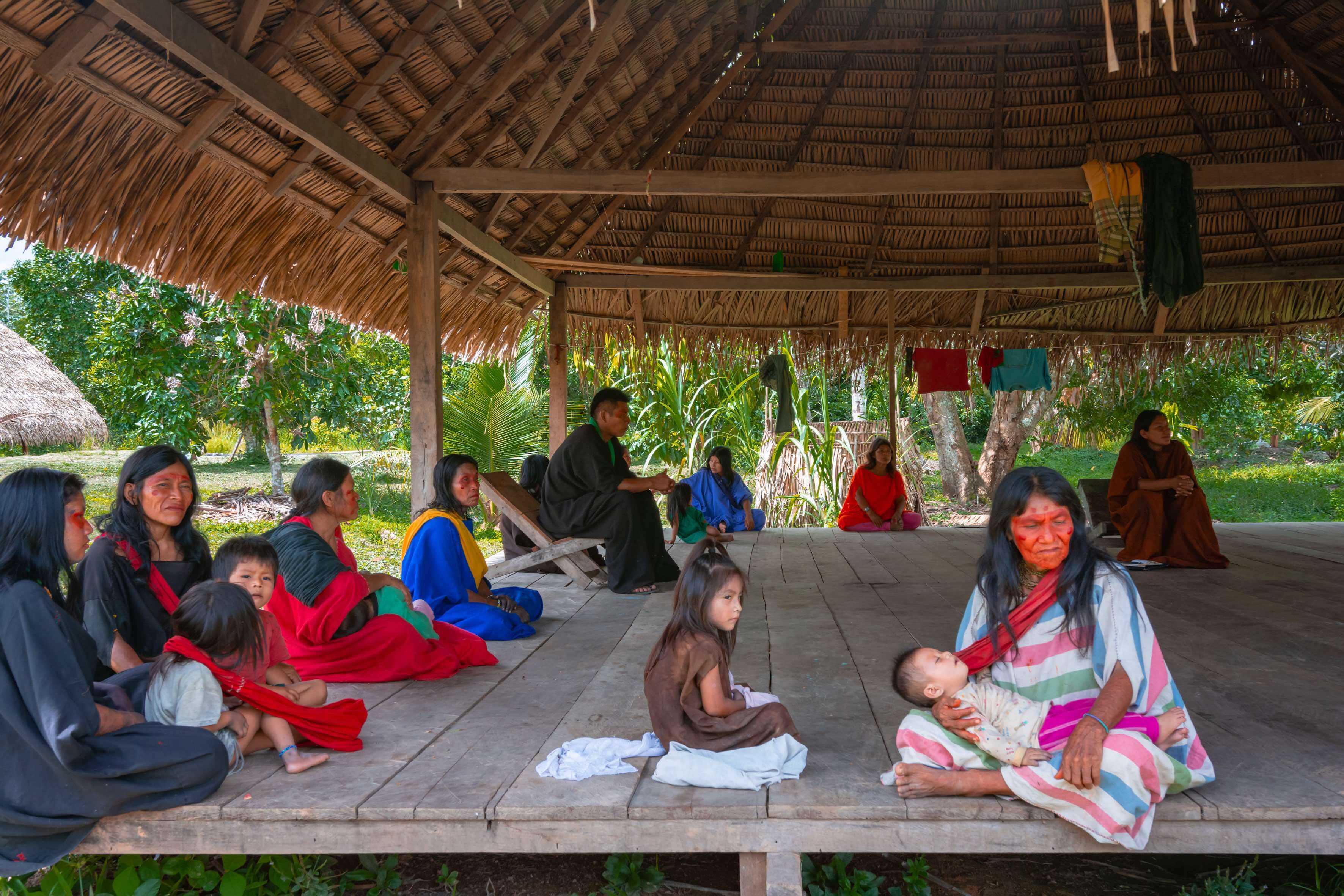
SUPPORT. Sawawo community leaders are concerned about the levels of harassment and threats in the area.
In addition to the rupture between the two indigenous communities, disagreements over the opening of the road have placed the region's two Asheninkas mayors on opposing sides. In Brazil, Isaac Piyãko (brother of Francisco), who has been managing Marechal Thaumaturgo for more than six years, opposes the reopening and operation of logging companies.
“Isac carries the message that both can be done. Modernize, bring novelty, provided that this novelty strengthens the family, the quality of life and does not destroy this beautiful thing that we have. It is possible to modernize without losing values," says Francisco Piyãko.
On the Peruvian side of the border, Yurua’s mayor, Ronaldo Tovar Alva, elected by Fuerza Popular, is a firm supporter of opening the road. In a speech he gave last year, Tovar expressed that historically there have never been conflicts among indigenous peoples in the region and accused NGOs of fostering division among the Asheninkas.
Tovar Alva indicates that the highway will improve teachers’ access to communities and the flow of products such as bananas. He mentioned Sawawo as an example of an isolated community, accessible only after a 12-hour walk. “I, as an authority, assure you that people ask for the road."
Through WhatsApp, OjoPúblico repeatedly requested an interview with Tovar, but there was no response.
"Tovar came from another region of Peru, from a more urban vision. And he dares to do everything wrong and he confronts with the values, the ideas of the community. He speaks Ashaninka, he dresses Ashaninka, but his base is a different people," says Francisco Piyãko, leader of the Amônia basin.

NEEDS. Sawawo health post. Vaccination arrived late to this community, and the leaders point out that there is often a lack of medicines.
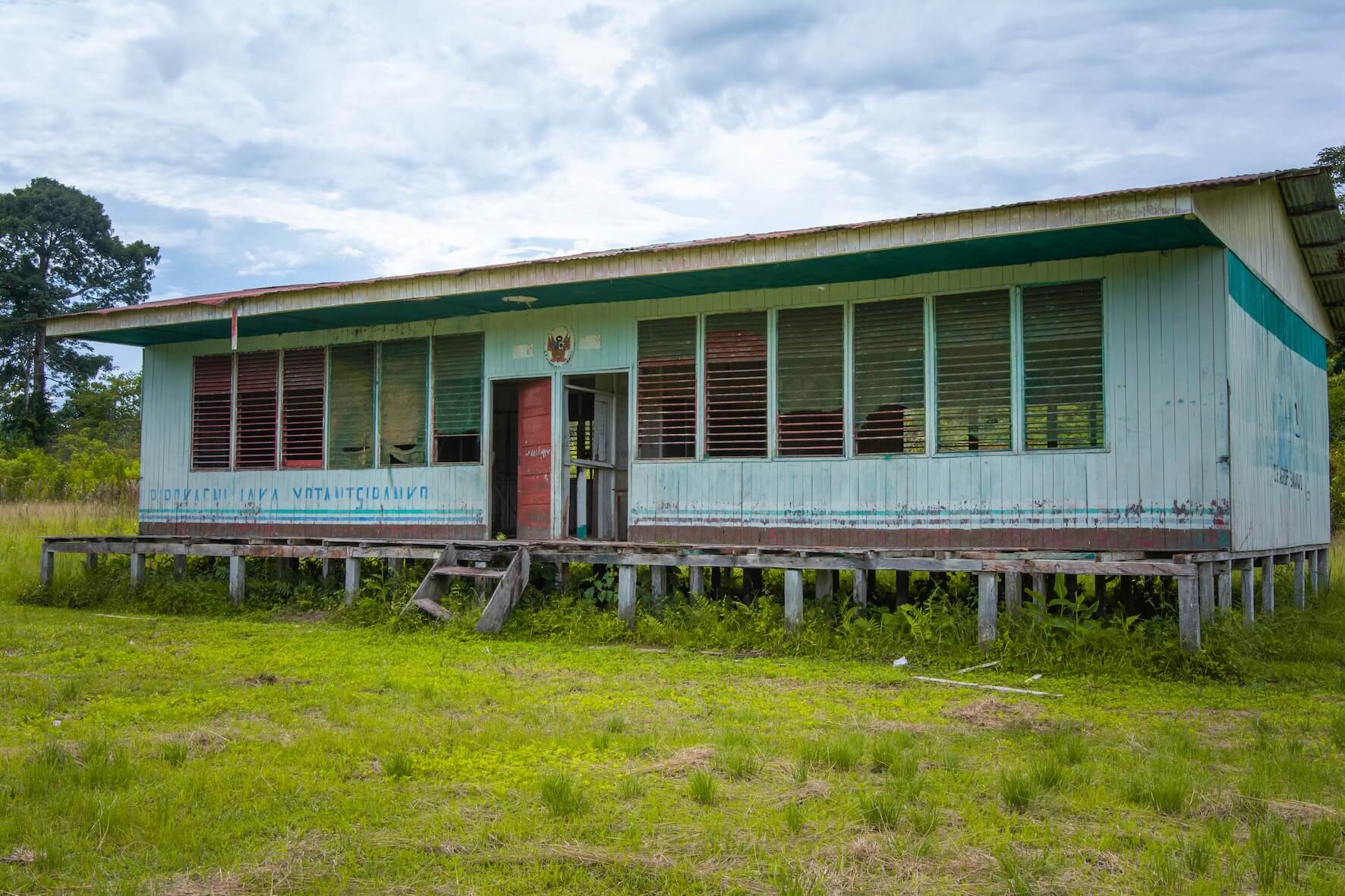
EDUCATION. The Sawawo community has multi-grade classrooms, but textbooks do not always arrive on time. The pandemic affected learning.
Unauthorized road
The attempt to open the road linking Nueva Italia- Sawawo- Breu is illegal. Although projected by the Ministry of Transport and Communications with the number UC-105, OjoPúblico verified that the road does not have any type of environmental or construction authorization from the authorities.
However, local leaders denounce that logging companies insist on widening the road, which until earlier this year was narrow and almost hidden by the forest seen from above with the drone. There was no sign of work resuming, but during our visit to the area we observed recent motorcycle tire marks revealing that there has been traffic.
The movement of these vehicles in such an isolated area suggests the use of the road by drug traffickers, local leaders say, because they claim it is not a route they use. In recent years, coca cultivation and cocaine refining have grown rapidly in Ucayali. For logistical and demand reasons, all local production goes to Brazil, either for consumption in that country or part of the route to other markets.
This expansion is already affecting some 80 native communities in Ucayali, representing 30% of the total, according to the report on the situation of indigenous defenders in this area, conducted by ORAU, Dar and ProPurus.
In Sawawo, a recent occupation on the margins of the timber road has raised fears of approaching drug trafficking.
“We are very concerned about an association of producers in Yurua that is almost adjacent to the community. This organization is bringing many illegal jobs, and that’s a big threat to us,” mentions Paredes.

ILLEGAL. Despite the fact that there is no authorization for road construction in the area, Sawawo leaders denounce that loggers have brought machinery to widen a road.
Foto: OjoPúblico
Although drug trafficking is on the rise in Jurua, the Attorney General of Acre says that, unlike Bolivian authorities, there is almost no collaboration between the Brazilian and Peruvian authorities.
"Peru spent two years with its borders closed, without any effective contact. At a meeting in October, we began to forge a new intelligence network in Peru, to establish the same deals we have in Bolivia. But this ideological and political rupture that occurred in Peruvian territory ended with the erosion of the intelligence network. All Peruvian commanders were changed. Today, the collaboration we have is through the [Federal Police in Lima] attachés, who provide us with information," says the Brazilian official.
The lack of territorial control by the Peruvian State has led to an increase in cocaine trafficking, as well as in cocaine seizures since 2018. Last year, almost 3 tons were confiscated in Acre. In the first three months of this year alone, about 500 kilos have been produced. Most of the drug comes from Ucayali. These data come from the Secretary of Justice of Acre.
In this crossfire, the Amônia River Ashaninkas, estimated at about 1,200 people on the Brazilian side alone, organize to prevent organized crime from definitively installing in the region.
This is mainly a question of political coordination. Unlike Peru, where the Ashaninkas have the image of warriors for their fight against Shining Path, in Brazil, with a much smaller population, the people, led by the Piyãko family, stand out for their political prowess.
The strategy of the Ashaninkas on both sides of the border includes the search for alliances with leaders of the Peruvian side and the national indigenous movement in Brazil, and the approach to the Brazilian Army, the main State presence in the region, with a border platoon in Marechal Thaumaturgo.
The Acre police have only nine men in the city and, according to Brazilian legislation, cannot operate in indigenous areas because they are federal areas, while international drug trafficking is the responsibility of the Federal Police.
The vast majority of the Ashaninkas live in Peru, where 55,493 members of this people were identified in the National Census of 2017. In Brazil, Ashaninkas are not more than 2,000 people, more than half of whom live in the Amônia River.
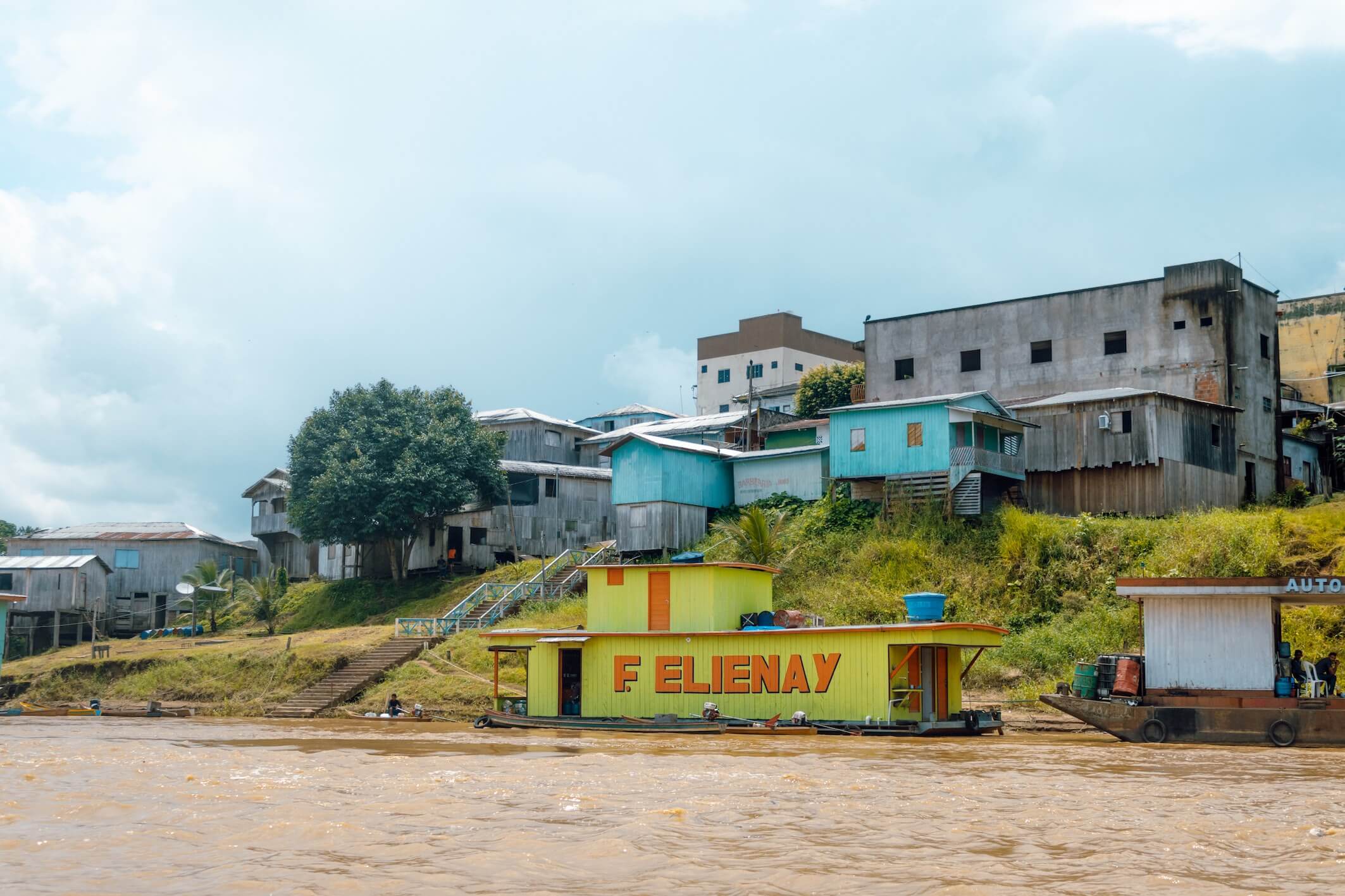
FRONTIER CITY. Marechal Thaumaturgo, in Brazil, is a city of 20,000 people.
Foto: OjoPúblico
The Brazilian Ashaninkas have achieved several political feats. Isac, re-elected in 2020, is the first indigenous mayor in Acre’s history. His brother Francisco was State Secretary for Indigenous Affairs in the state for eight years and will now seek a position as a federal deputy in Congress. In Brazil's history, only two indigenous people have been elected to this position.
At the national level, the Ashaninkas have also become prominent at different times. They were the first indigenous people to have a project approved by the Amazon Fund, which, funded by the Norwegian government, is the largest international cooperation project to preserve the Amazon rainforest.
In the Supreme Federal Court (STF), they won a historic victory against the family of Acre's current governor, Gladson Cameli, for illegal logging between 1981 and 1987. Part of the case involves an agreement to pay a compensation of 14 million reais to the Amônia River Ashaninkas and an apology “for all the damage caused, respectfully acknowledging the enormous importance of the Ashaninka people as the guardian of the jungle”.
Through ayahuasca, the Ashaninkas have also created a social project for non-indigenous people, in order to remove young people from the region from the temptation of drug trafficking.
In Marechal Thaumaturgo, a city of 20 thousand inhabitants, the spiritual leader Benki Piyãko, brother of Francisco and Isaac, created and directs the Yorenka Tasorentsi Institute. In an area of 1,500 hectares on the banks of the Jurua River, he teaches family farming techniques to 50 young people in the region. Part of the financing comes of the curative treatments he promotes through the traditional use of ayahuasca.
For Francisco, the eldest of the Piyãko brothers, it is necessary to act on several fronts to prevent crime from taking power. “Our resistance will not be strong if our environment is under control. If our environment weakens, we will be alone in this war, and this is very dangerous for us. So, our security here to deal with traffic is to say we don't accept it, we don't want it."
During the pandemic, threats and murders of indigenous leaders in Amazonian territory increased. So did the cultivation of illegal coca leaf and the illegal extraction of natural resources, along with the strengthening of criminal organizations. In June of this year, the murder of British journalist Dom Phillips and Brazilian indigenous expert Bruno Pereira on the Brazilian-Peruvian border (Yavari) once again exposed the risks faced by indigenous communities and the dispute over control of transit by criminal groups.
 Tienes reportajes guardados
Tienes reportajes guardados










